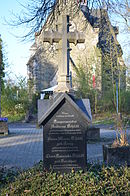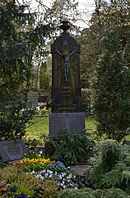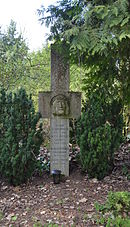Main cemetery Limburg an der Lahn
The main cemetery in Limburg an der Lahn from 1882 stands as a complete system new cemetery under monument protection .
history
After the cathedral cemetery had become too small, the new cemetery was laid out in 1882. The new installation took place on a rectangular plot of land on the Unterheide am Schafsberg , outside the city. The cemetery was enclosed by a wrought iron grating. This was removed in World War II. Only the gates of the main portal remained. In 1965/66 and 1985 the cemetery was expanded.
The cemetery is divided by five parallel avenues with different deciduous trees or cypresses, between which cross paths run. The central axis leads to an oval cross hill. There is a crucifix with a bronze body on it. Behind it is the grove of honor for the fallen soldiers of the First World War.
This leads into the semicircular cemetery of the Second World War with the Stalingrad monument, another high cross and the roundabout with the wooden cross of the country teams. In addition, in 1959/60, the cemetery parts with the dead Russians and Poles and honorary departments for the dead of the world wars were laid out.
Stalingrad memorial
In the main cemetery of Limburg an der Lahn, the central German memorial was inaugurated on October 18, 1964 to commemorate all soldiers who died in the Battle of Stalingrad and who subsequently died in captivity. In 1988, the city of Limburg took over the “Stalingrad Fighters Foundation” and thus ensured the preservation and maintenance of the Stalingrad Memorial, even through the existence of the “Bundestag Former Stalingrad Fighters”. V Germany ”. The federal government decided to dissolve it in 2004.
New cemetery chapel
The new cemetery chapel is located in the northern extension area of the cemetery. This was built in 1972/73 by the architect Franz Josef Hamm. A round mosaic from the former Offheim chapel had been embedded in the left entrance area of the chapel since 1979 . The mosaic from 1917 by the Art Institute for Glass Mosaics Ambrosi and Wünschmann (Berlin-Neukölln) originally served as an altarpiece there. The mosaic with a diameter of approx. 2.80 m shows a Vesper picture (the mourning Mary with her dead son on her lap) and eighteen stars against a gold background. Before the chapel was demolished in 1967, the mosaic was removed and restored in 1978/79. For artistic and historical reasons, the mosaic is protected as an individual monument.
Listed graves
| image | Name (s) | year | description |
|---|---|---|---|
 |
Mayor Andreas Schlitt | at the end of the 19th century | Simple cross on a pedestal made of dark marble , enclosure made of low red sandstone posts with iron pipes. |
| Building contractor David Brötz (1859–1929) and his wife Katharina, b. Zingel | 1920s | The grave stone is designed as antique-style temple front, in Fronton of the triangular pediment the initials DB. | |
 |
Menges and Meyer-Sartori family burial site | Large display wall from the turn of the century made of sandstone with embedded marble inscription plate , central gable risalit , in the gable there floral decoration; to the side tondi with winged putti heads ; Parapet with delicate wrought iron bars. | |
 |
Family burial site Johann Georg Brötz (building contractor) | Stately canopy, the four columns of which are decorated with braided borders and fantasy capitals made of gray stone. A stele with a marble urn and bronze inscription tablets rises below it. Enclosure of the tomb with wide vases. | |
| Family grave site Theodor Breidling (master watchmaker) | The tomb was established with the first burial in March 1893.
A fundamental restoration and redesign took place in summer 2019. |
A crucifix made of white Carrara marble rises above a gray rustique base made of artificial stone and a polished black granite stele with gold-leaf inscription of the first occupancy .
The area is laid out with white grit. In the middle is a cushion stone made of polished black granite with gold leaf inscription of the second occupancy. |
|
 |
Brühl family burial site | Turn of the century edging with fluted cast iron posts with acanthus decorations , heavy, angular chain links; two of the tombstones consist of crucifixes with bronze figures on marble steles | |
 |
Family grave site Carl Trombetta († 1903) | early 20th century | Extremely stately grave complex made of black marble: aedicule with two full Tuscan columns, flanked by two wing walls that are decorated with delicate bronze friezes (laurel garlands). Elaborate grave border made of marble posts, bronze balusters and cross braces as well as heavy chain. According to the inscription, the stonemason was F. Hofmeister, Frankfurt a. M. |
 |
Tomb of Josef Menges and Lina Menges († 1904, † 1910) | early 20th century | The sculpture of a grieving woman made of light marble kneels on a high pedestal made of black marble, holding a wreath of flowers in her hands joined in prayer |
 |
Reuter family burial site | second decade of the 20th century | In the center an aedicula with fluted columns, high rectangular wing sections. In the lower middle section, a standing, dead Christ carved without a cross at a later date |
 |
Otto Goebel's grave site (later use) | second decade of the 20th century | Column construction made of gray stone with a round arch crown, in it a relief of the crucified Christ, who is flanked by kneeling angels; the crown of thorns hanging on the cross becomes rose tendrils in the hands of the angels, poor state of preservation. |
 |
Family burial site Carl Hilf († 1909) | Neo-Romanesque structure consisting of a large, central stele with side wing parts. The central part is flanked by short Romanesque columns (cube capitals with tendril ornaments), which support a slightly pointed arch, in the arched area high quality mosaic depicting a Pieta, above the mosaic a winged putti head. Bordered with low stone pedestals, but the chains around it have been lost. | |
| Grave of Heinrich Lellmann, master bricklayer | Aedicula with slender full columns and triangular gable, the relief indicates an altar sausage with a cross rising above it (later a small bronze cross). | ||
| Grandpré family burial site | Large cross on a stele made of gray stone, in the middle a bronze medallion with a Christ head is embedded. | ||
 |
Ohl family burial site | second decade of the 20th century | Porphyry stele with accompanying wing sections, in the center a tall rectangular bronze relief depicting a woman leaning against a bookcase and looking at an hourglass; rose tendrils on the side panels. |
 |
Grave of Josef Hartmann, master carpenter (1853–1917) | White ashlar; fluted Doric columns supporting a curved gable; Cross with a bronze medallion with the head of Christ. | |
 |
Grave of Dr. Fritz Scholl (second occupancy) | second decade of the 20th century | Broad stele shape made of light stone in romanizing forms: a round arch with an inscribed clover leaf arch rises above ornamented console pieces, which frames a crucifix with a bronze figure of Christ, the letters Alpha and Omega on the side. |
 |
Rudolf Goerlach grave († 1906) | early 20th century | High tombstone crowned by a medallion of a cross with the relief of a kneeling woman with long hair planting flowers; lateral plant troughs; |
 |
Wilhelm Scheid burial site | White marble, Gothic stele with tracery decoration and crowning finial , flanking inscription plates. | |
 |
Family burial site Jakob Wolff | Three-part gravestone made of gray stone with a three-pass closure, projecting center like a risalit, above which the relief of a Pietà group appears. In the center is a rectangular bronze relief, which shows the head of the deceased in three-quarter view, including two Aesculapian snakes as a sign of his profession . The overall design comes from Arnold Hensler, the Pieta and the portrait relief are his own early works. | |
 |
Albert Henninger burial site | High round-arched tombstone made of black marble with an inscribed crucifix (bronze figure of Christ), crowned by a marble vase. | |
 |
Obenauer family burial site | second decade of the 20th century | Six fluted Doric columns support a piece of entablature with five rosettes; in front of it a large urn on a stele. Low restriction. |
 |
Lehnard family burial site | second decade of the 20th century | High tombstone with a curved end, which is supported by two columns decorated with garlands. In the center bronze relief with profile view of Christ with a halo. |
 |
Family grave of Dr. Jakob Höhler | executed around 1930 | High cross with thorn-crowned Christ's head, based on a design by Arnold Hensler from Steinmetz Hilf, Limburg. |
Former cemetery chapel
The former Catholic cemetery chapel was built from 1894 to 1896 according to plans by the Limburg architect Jakob Fachinger and is now a listed building. The chapel stands outside the actual cemetery in front of the main entrance. Today it is used as a restaurant.
It is a building made of rubble stones (green scarf stone) with house framing of the portals and tracery windows. A steep, slate-covered roof with a wooden roof turret and several dormer windows characterize the exterior.
photos
- Joseph Schneider (CDU), Mayor of Limburg 1945–1960
- Anna Ohl (1893–1987), founder, honorary citizen since 1986
- Heinrich Anton Wolf , District Administrator
- Ernst Eichinger , artist, lecturer in painting

Material: Westerwald basalt
literature
- Verena Fuchß: Monument Topography City of Limburg , 2007, ISBN 978-3-8062-2096-4 , pp. 138-143
Web links
- City of Limburg: Stalingrad memorial at the main cemetery , accessed on May 29, 2013
- State Office for Monument Preservation Hessen (Ed.): Former cemetery chapel In: DenkXweb, online edition of cultural monuments in Hessen
- State Office for Monument Preservation Hessen (Hrsg.): Entire facility Neuer Friedhof In: DenkXweb, online edition of cultural monuments in Hessen
Individual evidence
- ↑ Stalingrad monument at the main cemetery. on: limburg.de
Coordinates: 50 ° 23 '4.8 " N , 8 ° 2' 53.2" E













